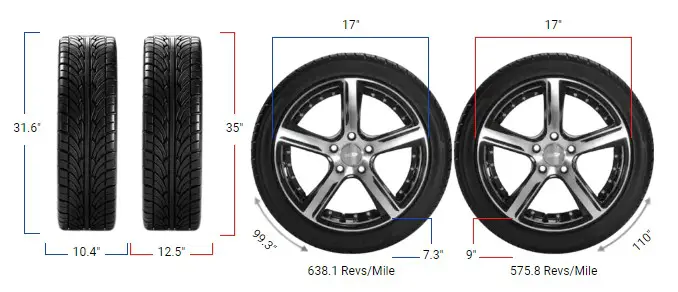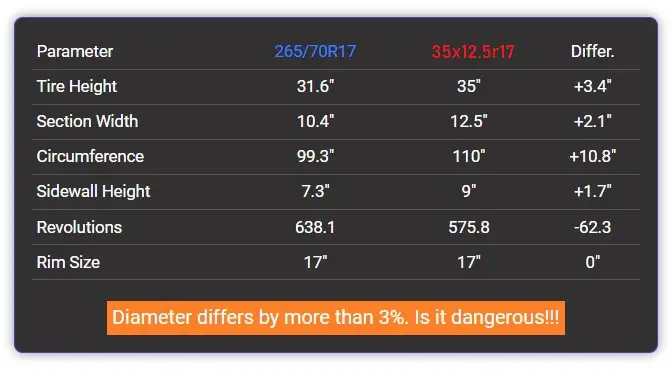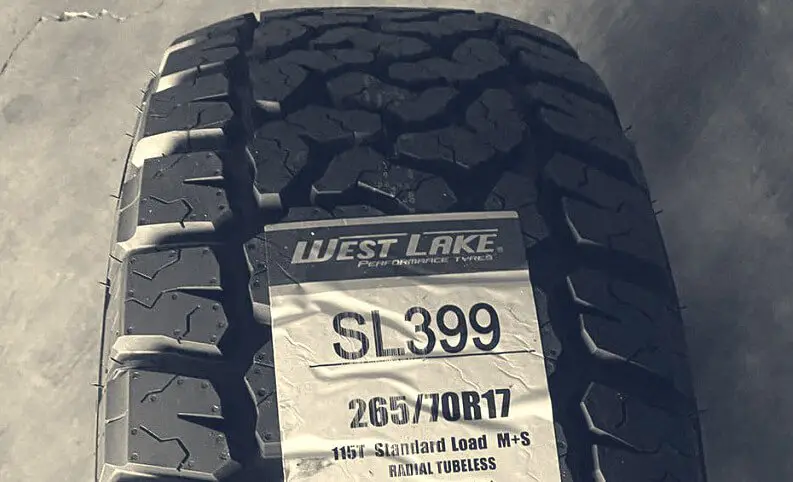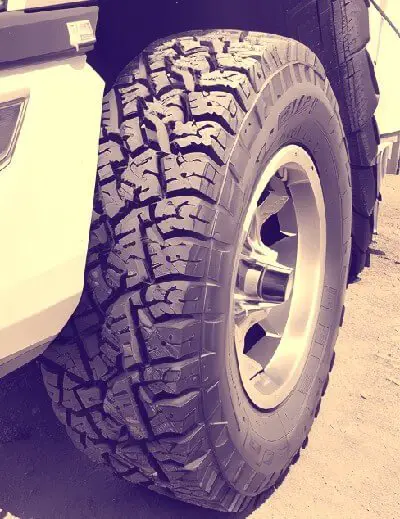Tire Size 265/70r17 vs 35×12.5r17

Switching from 265/70r17 to 35×12.5r17 tires is a popular upgrade, but it’s not a simple swap. This change brings significant impacts on your vehicle’s performance, both on and off the road.
- Increased ground clearance improves off-road capability
- Wider tread provides better traction in various terrains
- More aggressive appearance appeals to off-road enthusiasts
- Decreased fuel efficiency due to increased weight and rolling resistance
265/70r17 vs 35×12.5r17

Fitment Guide
It’s crucial to follow the fitment guide to ensure compatibility and safety. The general rule of thumb is that replacement tires should be within 3% of the original tire’s overall diameter.
In this case, the switch from 265/70r17 to 35×12.5r17 results in a 10.8% increase in diameter, which far exceeds the recommended range.
Given this significant difference, the interchange is not recommended without making necessary adaptations. These modifications may include:
- Lift kit installation: To provide additional clearance for the larger tires.
- Fender trimming: To prevent rubbing against the wheel wells.
- Wheel spacers: To adjust the tire position and prevent interference with suspension components.
- Gear ratio changes: To compensate for the larger tire size and maintain proper engine performance.
It’s important to note that these modifications can be costly and may affect your vehicle’s warranty. Always consult with a professional before making such significant changes to your vehicle.

On-Road Impact
The switch to 35×12.5r17 tires will have several noticeable effects on your vehicle’s on-road performance:
- Speedometer Accuracy: Due to the larger diameter, your speedometer will show a slower speed than you’re actually traveling. For example, when your speedometer reads 20 mph, you’ll actually be moving at 22.17 mph. This discrepancy increases at higher speeds, potentially leading to unintentional speeding.
- Fuel Efficiency: Larger, heavier tires require more energy to rotate, which can lead to decreased fuel efficiency. You may notice a drop in your miles per gallon (mpg) after the switch.
- Handling: The wider tires may improve straight-line stability, but they can also make steering feel heavier and less responsive, especially during low-speed maneuvers like parking.
- Ride Comfort: The taller sidewalls of the 35×12.5r17 tires (9.01 inches vs. 7.3 inches) can provide a smoother ride by absorbing more road imperfections. However, the increased unsprung weight may also make the suspension work harder, potentially reducing overall comfort.
- Braking Distance: The larger contact patch of the wider tires can improve braking performance on dry roads, but it may increase stopping distances on wet surfaces due to the risk of hydroplaning.

Off-Road Impact
The switch to 35×12.5r17 tires can significantly enhance your vehicle’s off-road capabilities:
- Ground Clearance: The increase in diameter provides an additional 1.71 inches of ground clearance, allowing you to navigate over larger obstacles and through deeper water crossings.
- Traction: The wider tires offer a larger contact patch, improving grip on various terrains such as mud, sand, and rocks.
- Floatation: The increased width helps distribute the vehicle’s weight over a larger area, reducing the risk of sinking in soft surfaces like sand or snow.
- Durability: Larger tires often have stronger sidewalls, making them more resistant to punctures and damage from off-road hazards.
- Aesthetic Appeal: The more aggressive look of the larger tires can enhance your vehicle’s overall appearance, giving it a more rugged and capable stance.

What is the Main Difference Between 265/70r17 and 35×12.5r17?
The most striking difference between 265/70r17 and 35×12.5r17 tires is their size. The 35×12.5r17 tire is a whopping 3.42 inches (86.92 mm) larger in diameter, which is a 10.8% increase.
Can I Use 35×12.5r17 Instead of 265/70r17?
No, using a 35×12.5r17 tire instead of a 265/70r17 is not recommended, as the size difference exceeds 3%. This could negatively impact vehicle handling, speedometer accuracy, and performance.
How Much Taller Is a 35×12.5r17 Tire Than a 265/70r17?
A 35×12.5r17 tire is approximately 3.42 inches (86.92 mm) taller than a 265/70r17 tire, representing a 10.8% difference in diameter.
How Much Wider is a 35×12.5r17 Tire Than a 265/70r17?
The 35×12.5r17 tire is about 2.09 inches (53 mm) wider than the 265/70r17 tire, which is a 20% difference in width between the two sizes.
Our Observation
Switching from 265/70r17 to 35×12.5r17 tires is a significant upgrade that comes with both benefits and drawbacks.
Off-road, the larger tires offer improved ground clearance, traction, and obstacle-handling capabilities, making them ideal for serious trail enthusiasts.
However, on-road performance may suffer, with potential decreases in fuel efficiency, handling responsiveness, and speedometer accuracy.
The 10.8% size difference is substantial, requiring vehicle modifications and careful consideration of your driving needs. While the off-road benefits are clear, the on-road compromises shouldn’t be overlooked.

Meet Caitlin McCormack, a Tire Size Expert and Blogger Passionate About Everything Related to Tires. With Years of Experience in the Tire Industry, Caitlin Has Become an Expert in Tire Sizes and Their Impact on Vehicle Performance.
